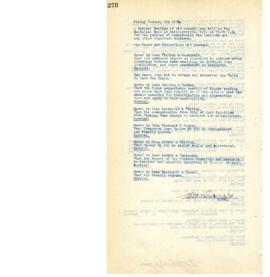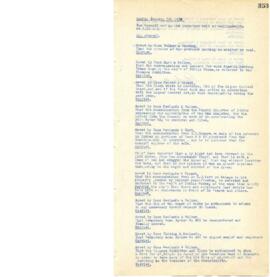Title and statement of responsibility area
Title proper
Regular Council Minutes
General material designation
- Textual record
Parallel title
Other title information
Title statements of responsibility
Title notes
Level of description
Series
Reference code
Edition area
Edition statement
Edition statement of responsibility
Class of material specific details area
Statement of scale (cartographic)
Statement of projection (cartographic)
Statement of coordinates (cartographic)
Statement of scale (architectural)
Issuing jurisdiction and denomination (philatelic)
Dates of creation area
Date(s)
-
1891-2012 (Creation)
- Creator
- City of Coquitlam. Council and Office of the City Clerk
- Note
- 1897-1908 and 1964 minutes have not survived
Physical description area
Physical description
2.8 m of textual records
Publisher's series area
Title proper of publisher's series
Parallel titles of publisher's series
Other title information of publisher's series
Statement of responsibility relating to publisher's series
Numbering within publisher's series
Note on publisher's series
Archival description area
Name of creator
Administrative history
The position of the City Clerk was established at the first meeting of the District of Coquitlam Council on August 22, 1891 and R.D. Irvine was engaged at the salary of “not more than $50.00 for the balance of year”. Originally the treasurer, assessor and records manager for the District, the City Clerk eventually became Municipal Council liaison with a separately appointed Treasurer. The Clerk’s chief function is to be secretary to Council, Council Select and Special Committees, to the court of property tax revision and secretary to the Board of Variance and Family Court Committee. The Clerk is responsible for Council correspondence and for civic public relations. The Clerk is also the Returning Officer for elections to Council and the School Board and is the custodian of the municipality’s bylaws. Since the Clerk’s Office has responsibility for record keeping, its records serve as one of the more diverse sources documenting Coquitlam’s development as a municipality.
The area between New Westminster and Pitt River along the Fraser River in British Columbia became settled in the pursuit of trapping, fishing and logging beginning in the
1820’s. Industry and significant settlement began with the opening of Fraser Mills sawmill on the north bank of the Fraser in the last years of the 19th century. Coquitlam comprised an area of approximately sixty-five square miles that had been surveyed by Royal Engineer A.L. Breakenridge in 1863. By the late 1880s, it became evident that the area should be incorporated into a Municipal District, and to this end, a petition was made by a majority of the landowners and pre-emptors living in the area. By letters patent dated 25 July 1891,
the area was incorporated as the Corporation of the District of Coquitlam. The letters patent called for the nomination of five councillors and a reeve and the first meeting of a municipal council were assembled in Kelly’s Hall in 1891 at Westminster Junction, now within the City of Port Coquitlam. The first reeve was R.B. Kelly and the first councillors were E.A. Aitkins, James Fox, S.W. Selman, James Morrison and J. Shennan. The first City Clerk was R.D. Irvine.
In 1893, that portion of the Maple Ridge Municipality between the newly formed District of Coquitlam and the Pitt River was added to Coquitlam municipality. The City of Port Coquitlam and the District of Fraser Mills both ceded from the District of Coquitlam in 1913 in order to limit their tax liability for the development of the rapidly growing Coquitlam District and to establish their own tax base, taking just over a almost 7000 acres of land away from the Coquitlam District. Fraser Mills rejoined the District on 1 November 1971, when both districts revoked their letters patent and a new letters patent was proclaimed incorporating the area as the District of Coquitlam. Supplementary letters patent were issued in 1973 and 1986 to reflect changes in municipal boundaries. Effective 1 December 1992, the District of Coquitlam’s status was changed by new letters patent to that of a city municipality and it became known as the City of Coquitlam. Today, it is bordered by the municipalities of Port Moody, Port Coquitlam, Burnaby and New Westminster as well as the Fraser River to the south, Pitt River to the east and the Coastal Mountains to the north. It includes the community of Maillardville, a region near Fraser Mills settled by French Canadians in the early years.
History of the municipality’s bylaws indicates both the remoteness of the region and its rapid urbanization. Road taxation began in 1897, the sale of liquor was first regulated in 1909 and municipal health regulations were first passed in 1912. Coquitlam had electricity by 1911, and plans for running water began in 1916. The building of a separate fire hall in 1946 and expansion of water service in the mid-1950s indicate a particularly vigorous period of population growth. The municipality assumed responsibility for paved roads and sidewalks by 1961. Zoning changes in the 1970s and 1980s reflect a change in land use from agricultural to single-family suburban residential and low-density apartment housing. An average of two development permits was issued every month by the early eighties.
The town centre, developed in the mid 1970s, provides cultural and recreational facilities and includes a public safety building, a new City Hall, community centre, a high school and college. The population of Coquitlam has doubled from the 1970s to the present day. A dyking project began in the 1990s has eliminated the Coquitlam River flooding and bridge washouts that sometimes occurred in the last century.
City Clerks, District and City of Coquitlam
R.D. Irvine 1891-1892
W. Alexander Philip 1892-
John Smith 1899-1913
A. Haliburton 1913-1917
Robert Newman 1918-1927
Alan M. Shaw 1928
William Russell 1928-1947
F.L. Pobst 1947-1972
R.A. Leclair, acting clerk, 1965, 1966 1967
H.F. Hockey, acting clerk, 1967
Ted Klassen, acting clerk, 1967
Ted Klassen, 1972-1991
Sandra Aikenhead, 1991-1994
Warren Jones, 1994-2000
Trevor Wingrove, 2000-2002
Sonia Santarossa, 2002-2008
Jay Gilbert, 2008-present
Reeves and Mayors, District and City of Coquitlam
R.B. Kelly 1891-1896
E.A. Atkins 1897-1903
Ralph Booth 1904-1908
D.E. Welcher 1909-1910
James Mars 1911-1913
L.E. Marmont 1918-1922
George H. Proulx 1923
R.C. MacDonald 1924-1941
J.W. Oliver 1942-1944
L.J. Christmas 1945-1969
J.L. Ballard 1970-1971
James L. Tonn 1972-1983
Louis Sekora 1984-1998
Jon Kingsbury 1998-2005
Maxine Wilson 2005-2007
Richard Stewart 2008-present
Custodial history
Scope and content
Series consists of Council meeting minutes, the official record of the discussion and decision-making activities of the governing body of the City of Coquitlam and its predecessors (The District of Coquitlam and the Corporation of the District of Coquitlam). The minutes address all aspects of local municipal government, including municipal taxation, land and building regulation, public health, safety, culture and recreation, and public works. Confidential or sensitive issues are addressed in Executive (Closed) Council meetings, the minutes of which are maintained as a separate series.
Notes area
Physical condition
Arrangement
Arrangement of minutes is chronological.
Language of material
Script of material
Location of originals
Availability of other formats
Microfilm copies exist for 1891 to 1954 and 1964 minutes.
Digital copies available on Quest (1891-1896, 1909-1957).
Digital copies for 1958 to 1997 are available through Council Minutes Library Search available at: https://www.coquitlam.ca/129/Agendas-Minutes
Restrictions on access
No restrictions
Terms governing use, reproduction, and publication
Finding aids
Associated materials
Accruals
Accruals expected
General note
Minutes predating 1991 were scanned with the financial assistance of the Government of Canada through the National Archives of Canada and the Canadian Council of Archives.
General note
The Series was originally S04 in the City of Coquitlam Council and Office of the City Clerk fonds (F1).
Physical description
Minutes are handwritten until January 19, 1920






























